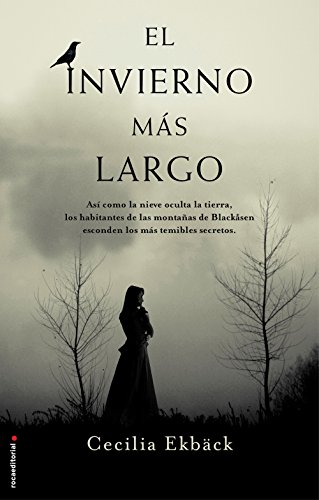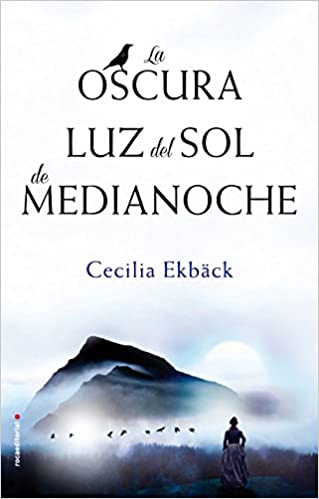There are certain analogies in the evolution of the Swedish and Spanish noir genre. Because in both cases it is they, writers, who captains the most suggestive offer with stories that maintain that taste for investigative noir. Women at the helm as writers and also as the protagonists of their stories. From Dolores Redondo o Maria Oruña but also Camilla Lackberg y asa larsson, to show similar examples to the north and south of Europe.
In the case of Cecilia Ekback, she shows a veteran age and maturity focused on this new subgenre of historical thrillers with a great load of criminalistic vision, investigation and plunging us into the depths of the soul of the most vicious murderers.
Thanks to that misty setting that hangs over our world in any past era, Ekback's approaches become fast-paced plots loaded with insurmountable tension. We find stories located in the 18th century or until the Second World War. Each moment and each place is carefully chosen to immerse us in a fully enjoyable Ekback scenography.
Cecilia Ekback's Top 3 Recommended Novels
The longest winter
Lapland, 1717. Maija, her husband Paavo and their two daughters, Frederika and Dorotea, have emigrated from Finland to Swedish Lapland, in the area of Mount Blackåsen. Paavo suffers from uncontrollable anxieties and fears, and had to give up his job as a fisherman. Now the family lives on a farm.
One morning, Frederika and Dorotea graze the goats at the top of the forest. There they find the corpse of a man. Maija will decide to warn the few and far-flung neighbors of the town of this event, which is a day's walk away, a dark and lonely place that only seems to come to life when the church bells summon people through Snow. It is there that even the oldest enemies of that community gather and leave their isolation to see each other again.
Maija will get to know each of the locals in her discreet investigation and will realize that, just as the snow hides the land, its inhabitants hide the most fearsome secrets. Everyone says that the death of that man, who turns out to be a member of the community named Eriksson, can only be due to a wolf attack. But what wild animal cuts a body in that way, with such clean and studied wounds?
The History student
It is 1943 and Sweden's neutrality in WWII is under pressure. Laura Dahlgren, the brilliant young right-hand man of the chief government negotiator, is aware of these tensions. However, when Laura's best friend from college, Britta, is discovered murdered in cold blood, Laura is determined to find the killer.
Before her death, Britta sent a report on racial discrimination in Scandinavia to the Secretary to the Foreign Minister, Jens Regnell. In the midst of negotiating a delicate alliance with Hitler and the Nazis, Jens does not understand why he received the report. When the search for Britta's killer leads Laura to their doorstep, the two decide to launch an investigation to find out the truth.
As Jens and Laura try to unravel the mysterious circumstance surrounding Britta's death, they begin to find themselves engulfed in a web of lies and deception that leads to a dark and twisted conspiracy, which appears to take place near a mysterious mountain called Blackåsen. A conspiracy that will change the way they view not only themselves, but their country, and ultimately their place in history. The war is violent and Swedish politics is on the tightrope. And Britta's death seems to be the key to all of it.
The dark light of the midnight sun
Every living being is subject to Cardiac rhtyms, established by the hours of daylight and darkness of the night. However, animals that live in the areas closest to the poles, where the effect of the midnight sun occurs, have known how to adapt to this particular permanence of the star king. Let's say that animals dispense with this biological regulation to be able to get into the environment.
For the human being it is not so simple. We can get used to it, but we are not free to suffer Harmful influences on this sunny hour overdose. We have all heard it said that in Scandinavian countries the affection of this astral "anomaly" can cause depression and other psychic imbalances ...
In any case, in this historical novel the peculiar intervention of the sun is just an excuse to settle in Lapland, that area shared between Norway, Sweden, Finland and Russia that sounds so exotic to any European from the center or the south.
In 1855, the mysterious midnight sun places us in Sweden, where atrocious chain murders have been carried out by a Lapp aborigine. The killer's motivations become the leitmotif of the plot. Because at all times it is sensed that the nomad's sudden homicidal instinct must find a compelling justification.
Mount Blackhasen appears to be the criminal's sole confidant. And Magnus, the geologist sent to unravel the tragic event seems to be the only one who can investigate and decipher what the deaths might hide. Impulsive murders may only appear so. Maguns begins to link the deaths with mysterious circumstances in the area, a kind of premeditation of death in collusion with the environment, with the ancient inhabitants of the place and with the need to survive.
If we add the general nineteenth-century touch to the investigation of the murders as an extraordinary complement to the setting of the story, we are presented with a novel to enjoy and savor, an unparalleled journey to a mysterious not-so-remote past.
Days without nights, games of dim lights that cause more shadows than clarity. Cold, a cold that penetrates the reader's bones in that icy setting of Nordic suspense. Cecilia Ekbak as one of the greatest writers within the inexhaustible mine of thriller writers from these countries so close and so far in turn.



